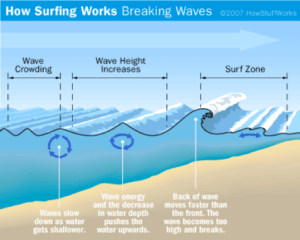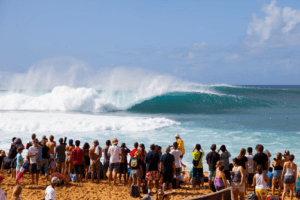Shocka Brah! How Climate Change Is Impacting the World Surf League

Rising sea levels, acidifying oceans, and increasing tropical storms put the World Surf League’s business at risk – and it needs to do more to save our waves
Long before today’s groms (young surfers) ever launched out of their first in-and-out barrel (riding inside the curl of a wave and then surfing out successfully) surfers had a deep passion for keeping our oceans pristine. Indeed, as a member of my high school surf team we joined with a coalition of southern California surfers to successfully block the building of a toll road which would have destroyed the waves at our local surf break. However, the threats against oceans and surfers continue to grow, driven by (1) rising sea levels, (2) ocean acidification, and (3) increasingly destructive coastal storms. The World Surf League (WSL), the top professional surfing organization, must leverage its leadership position within the surf community to mitigate the impacts of these risks.

Despite public perception of surfers (exhibit A), surfers have a long history of defending our oceans, led by organizations such as Surfrider and Surfers Against Sewage. These organizations oft quote NASA, which shows that sea levels are currently rising about 0.15 inches per year and are projected to rise 6.6 feet by 2100[1],[2]. Rising sea levels have a profound effect on surf breaks, specifically “beach breaks” in which an approaching wave is formed and caused to break by a sand bar (Exhibit B). When water levels rise, approaching waves hit sand bars at a different time, changing the size and shape of the wave. With key WSL tour stops at beach breaks (including Trestles in California and Jeffrey’s Bay in South Africa) this presents great risk for the WSL. Further, two of the tour’s most famous stops – Tavarua in Fiji and Teahupoo in Tahiti – are at significant risk of having their local islands submerged by 2050[3].

The second issue WSL must advocate to reduce is ocean acidification, or the rising level of CO2 in the world’s oceans. Over the past ~100 years the pH levels of our oceans have dropped by 30%, and are projected to drop by another 150% by 2100[4]. This has a detrimental effect on calcifying species such as coral, specifically in their ability to produce calcium carbonate shells which could ultimately lead to shrinking coral reefs. For surfers, coral reefs play a crucial role in the production of some of the best waves in the world, including WSL tour stop Pipeline on the North Shore of Hawaii (see Exhibit C). Coral reefs cause approaching waves to form and break more quickly, as they provide more resistance to the approaching wave than does a sand bar, leading to unrivaled “barrels”, or hollow waves. If these coral reefs shrink due to ocean acidification so will the famed waves that they have created for centuries.

The final issue which the WSL must combat is the increasingly destructive nature of coastal storms. Recent research from Kent Emanuel of MIT shows that tropical storms are likely to become more frequent and destructive in the coming years, contrary to prior belief[5]. This presents a significant risk for surf breaks all over the world, as these storms can fundamentally change sand bar layouts and impact beach breaks. Further, additional risk lies in human response to these storms. If humans elect to build retaining walls or other protective measures near shorelines the nearby breaks will be negatively impacted.
The WSL’s position as the premier professional surf circuit affords it a great platform to lead this discussion, and indeed their partnership with Columbia University to launch WSL PURE (Progressive Understanding and Respect for the Environment) shows their forward-thinking approach. However, they should take additional action. First, they should make clear to all local regions where events are held that the communities must commit to sustainable behaviors or the WSL may move the local event to another break. Second, they must integrate more sustainability education into their interactions with surfers throughout tour events, e.g., publicly evaluating each event for its sustainability at the trophy ceremony. Finally, they must work with sponsors to ensure that companies advertising with WSL are adhering to sustainable practices or they will risk replacement. The WSL cannot solve these global issues alone, but by taking a more substantive stance to save our oceans they will serve as a beacon for other aquatic and extreme sports, and ultimately for ocean-goers in general.
Word Count: 786 words
[1] “Sea Level,” NASA website, http://climate.nasa.gov/vital-signs/sea-level/, accessed August 2016
[2] “Understanding Sea Level: Empirical Projections,” NASA website, https://sealevel.nasa.gov/understanding-sea-level/projections/empirical-projections, accessed August 2016
[3] Oliver Milman, “Pacific Nations Beg for Help for Islanders Forced to Flee,” Climate Central, The Guardian, October 17, 2015, http://www.climatecentral.org/news/pacific-nations-beg-for-climate-help-19558, accessed August 2016
[4] “What is Ocean Acidification”, National Ocean and Atmospheric Association, http://www.pmel.noaa.gov/co2/story/What+is+Ocean+Acidification%3F, accessed November 2016
[5] “Hurricanes Likely to Get Stronger & More Frequent: Study”, Climate Central citing PNAS, http://www.climatecentral.org/news/study-projects-more-frequent-and-stronger-hurricanes-worldwide-16204, accessed November 2016



Learn something new every day – never realized “grom” was a term for young surfer.
On a more serious note, I never appreciated the impact climate change had on surfing. Interestingly, we have seen top athletes in a number of sports take up important issues to help raise global awareness. For example, look at the case of Black Lives Matter. On this topic, LeBron James gave a powerful message at the ESPYs and Colin Kaepernick took a knee during the singing of the national anthem. I wonder if, in addition to the WSL, top surfers could help further this cause? Per the below article, it seems at least some in the sport are trying to make a positive impact:
https://thinkprogress.org/endless-summer-how-climate-change-could-wipe-out-surfing-9209acd46fb9#.rnpiq4cyf
Hopefully help is coming, but in the meantime, hang in there, bro.
Thanks for the article (and the humorous photo in Exhibit A). In general, I would like to better understand whether surfing itself is under threat, or whether existing surfing hotspots are under threat due to climate change.
While I agree that traditional surfing locations are threatened for the reasons listed in your article, I think that new surfing locations may gain fame. For instance, the El Nino storm events (see link below) will impact wave and surf heights in the Pacific, creating the potential for exciting, but potentially dangerous surfing locations.
https://podaac.jpl.nasa.gov/OceanEvents/2016_01_25_WavesSatellites_ElNino
I hope that the impact of climate change mitigation (e.g. sea walls) on the sport of surfing does not end up being existential. One of my major takeaways from Barbarian Days is how the faddish/fashionable nature of surfing has brought hordes of yuppies in quiksilver to even the most sacred and hidden locations. As mitigation efforts and worsening climate change continue to shift the nature of waves, I hope this means that the hardcore surfers continue to be able to chase the next great, unknown wave.
I have a deep fascination for sports leagues outside the big 4, so I really enjoyed reading this.
I like that you highlighted two ways climate change matters to the WSL — how it affects where the events can be held, and how it affects the behaviors of those involved in the events. While the WSL is a relatively small entity, for them to be successful in any attempt in mitigating against the effects of climate change they need to partner with big organizations like, as you mentioned, NASA and Columbia University. I agree that they should require the communities in which they compete to commit to sustainable practices. At the least, that seems to be within their influence.
Like the point above me makes, I too wonder how much the league will adapt to the effects of climate change, if at all. Does there emerge a different type of surfing that fans will have to appreciate? Or are these changes more likely to spell doom for the league, especially if fewer coral reefs means fewer waves worth surfing?